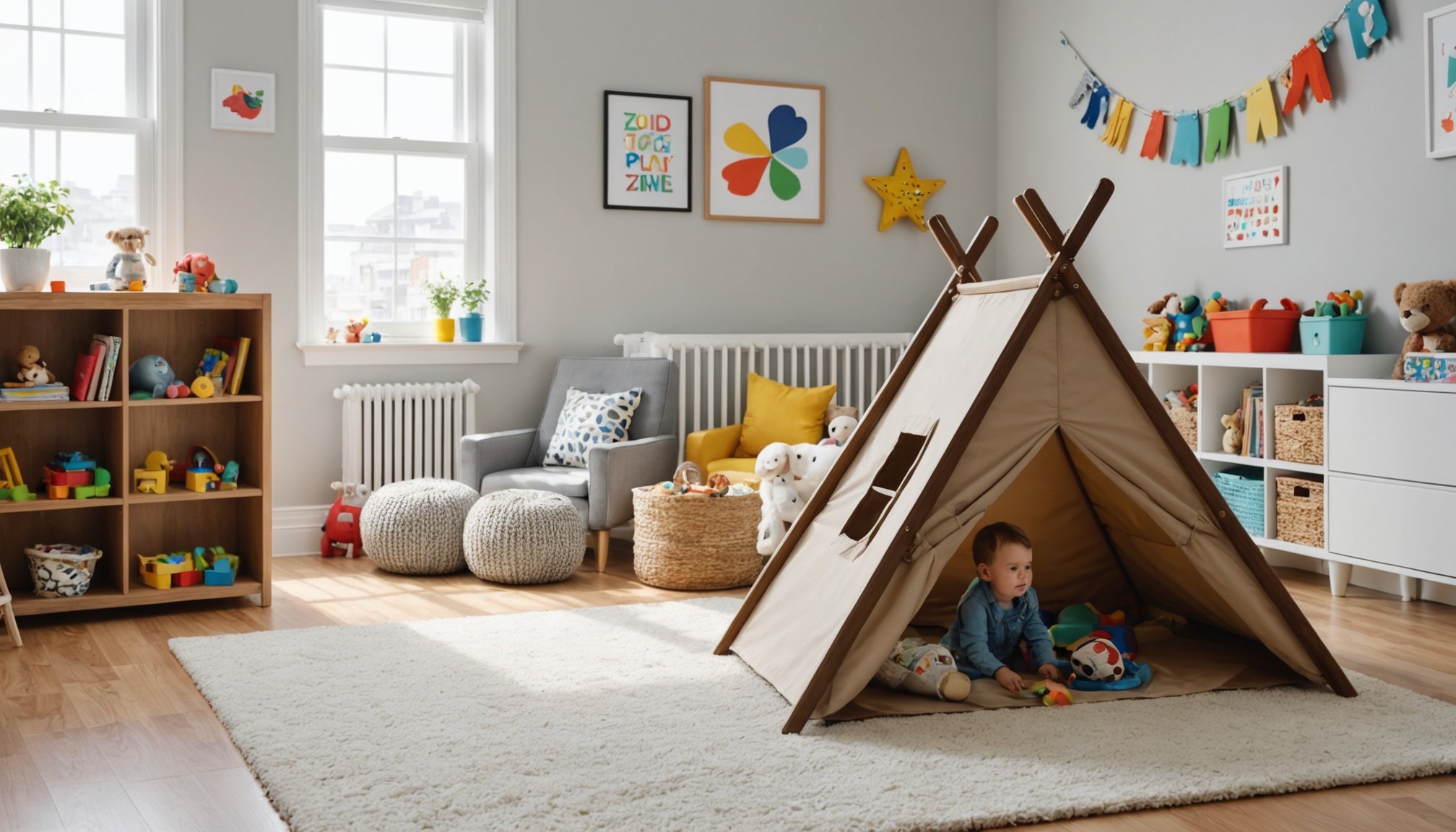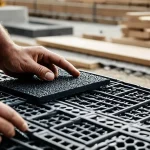Assessing Your Space for a Toddler Play Zone
Identifying available space in small apartments for a toddler play zone can be quite the puzzle. Place the emphasis on space assessment by examining each room’s layout. Take a critical look at the available nooks and corners that could be transformed into inviting play habitats. A thorough understanding of your apartment layout can ensure an efficient use of space, even in the tightest of spots.
Safety is a priority. When identifying areas, it is crucial to consider safety regulations. Ensuring accessibility and soft edges reduce hazards for adventurous toddlers. Evaluate existing furniture arrangements—could a bookshelf be moved to open up a new play zone? Could the couch shift slightly to allow for safe passage? Consider potential modifications to make the space more child-friendly.
Also read : Revitalize Your Creative Haven: Expert Tips for Crafting an Inspiring Scrapbooking and Fabric Arts Room
Consider the play zone’s accessibility, ensuring it’s easy for small hands and feet to navigate. By modifying furniture to suit their view of the world, you’ll promote a safe, accessible environment. With a bit of creativity in space assessment, your toddler could have their very own play paradise without overcrowding your home’s layout.
Safety Considerations for Toddler Play Areas
Ensuring a toddler’s safety within play zones is paramount. Begin by equipping the area with essential safety gear like soft floor mats to cushion falls. Furniture featuring rounded corners or adding corner protectors can thwart injuries. Additionally, wall anchors effectively prevent tipping accidents, crucial with inquisitive toddlers.
This might interest you : Revamp Your Kitchen: Clever Organization Hacks to Slash Food Waste
In terms of childproofing strategies, adhering to guidelines for age-appropriate materials significantly reduces risks. Opt for non-toxic, environmentally friendly materials, such as water-based paints and finishes free from hazardous chemicals. Outlets should be secured with covers to deter little fingers from exploring areas they shouldn’t.
When selecting resources, exercise caution to ensure all equipment meets safety standards. Toys and play equipment should be easy to clean, avoiding dirt accumulation which can lead to hygiene issues. Finally, organise play zones to have clear, wide pathways for safe navigation, reducing the likelihood of trips or falls.
Focusing on these strategies will enable you to create a safe environment that encourages playful exploration, fostering growth and development while ensuring peace of mind.
Space-Saving Solutions for Play Zones
Designing a play zone in a small apartment requires creative space-saving techniques to maximise utility. Consider multifunctional furniture like a storage ottoman that doubles as seating, or a folding table that tucks away when not in use. These dual-purpose items ensure you utilise the area effectively without crowding your space.
For those tight on room, vertical space can be your best friend. Install shelves to store toys and supplies up high, freeing up valuable floor space. Look for tall, narrow bookcases which can also house baskets for organising smaller play items. This not only improves space management but also keeps things tidy and accessible.
Portable play equipment, such as collapsible tunnels or pop-up tents, provide dynamic play without permanent space commitment. They can effortlessly be stored away when activities conclude, maintaining the room’s flexibility. Opt for durable, lightweight materials that are toddler-friendly yet easy for adults to manage.
Adopting these space-saving strategies will help create an uncluttered, efficient play environment that supports the active lifestyle of toddlers, while simultaneously preserving the balance of your home’s apartment layout.
Creating an Engaging Play Environment
An engaging play environment for toddlers harnesses the benefits of sensory activities, crucial for developmental growth. Sensory play stimulates the senses, supporting cognitive development and fine motor skills. Activities like sand play or water tubs allow exploration while enhancing coordination and creativity.
Selecting toys that promote creative play encourages exploration and imagination. Opt for open-ended toys, like building blocks or dress-up costumes, which enable toddlers to use their imagination in varied ways. These choices support problem-solving skills and social interaction, vital for well-rounded development.
Designing themed play areas based on the child’s interests can significantly boost engagement. By incorporating themes such as a mini jungle or a construction site, the play zone becomes a vivid world of discovery. This tailored approach keeps a toddler’s attention and optimises playtime by aligning with their curiosity and hobbies.
Investing thought into such play environments not only entertains but also educates, harnessing the power of play for your child’s growth.
Layout Suggestions for Optimal Play Flow
Creating an optimal play area layout is essential for encouraging active toddler movement and ensuring their safety. Begin by organizing the space to facilitate easy, unobstructed flow. This means having distinct zones for various activities, keeping the play environment structured yet accessible.
To accommodate different activities, separate areas like reading nooks, crafting corners, and sections for active play. This strategic segmentation helps manage toddler movement, allowing them to focus on the task at hand while reducing distractions. Utilizing rugs or low bookcases can subtly define these zones without the need for rigid barriers.
Maintaining a clutter-free environment simplifies navigation and minimises tripping hazards. Regularly rotating toys and materials can keep the play zone fresh and engaging, while preventing zone organization from becoming overwhelming. Opting for labelled storage bins streamlines tidying up and ensures everything has its designated place.
Implementing these strategies will enhance the play space functionality, offering toddlers the freedom to explore various activities safely while maintaining a structured environment conducive to their growth and development.
Product Recommendations for Safe Play Areas
Selecting the right products is crucial in designing safe play zones. Opt for the best toddler toys that foster learning and creativity, like stackable blocks or shape sorters. These options promote motor skills while ensuring safety through non-toxic, durable materials.
Evaluating safety standards is essential; look for certifications that guarantee products are free of hazardous chemicals. Many reputable brands focus on sustainability and eco-friendly options, meaning your child’s safety won’t come at the planet’s expense.
Consider recommended equipment like padded mats and wall-mounted storage solutions, which effectively create a safe and organised play environment. Being compact and space-efficient, these additions enhance any small apartment layout.
Local suppliers often provide excellent selections of sustainable toys, ensuring convenient access while supporting community businesses. Look for vendor reviews and product specifics to gauge the quality and longevity of the items you’re sourcing.
By prioritising high-quality, safe, and engaging products, you ensure a fulfilling play experience tailored to meet your toddler’s developmental needs, all while maintaining peace of mind regarding their safety.
Activity Ideas to Stimulate Development
Creating play activities that align with developmental milestones is essential for toddlers’ growth. Age-appropriate games and tasks enhance both cognitive and physical abilities, ensuring a holistic approach to development. For instance, simple puzzle-solving activities can improve problem-solving skills while focusing on hand-eye coordination.
Interactive games work wonders in engaging toddlers. Consider games that encourage communication and cooperation, such as Simon Says or colour matching tasks. These activities not only entertain but also significantly aid language development and social skills. Encouraging toddlers to participate in structured games can boost their ability to follow instructions and enhance social interaction.
On the creative side, crafting and artistic activities using minimal materials offer a wealth of developmental benefits. Simple projects like finger painting or creating shapes with clay foster creativity and self-expression. These tasks utilise basic household items, making them accessible and cost-effective.
Incorporating these developmental activities into a toddler’s routine will support their learning, exploration, and joy, capitalising on playtime for maximum developmental impact.
Real-Life Examples of Small Apartment Play Zones
Real-life examples of small apartment play zones offer a glimpse into innovative solutions for limited spaces. Let’s explore a few standout cases, providing you with practical inspiration and design ideas.
In one such example, a family in New York transformed a compact living room corner into a vibrant play zone. They utilised a multifunctional bookshelf, incorporating both storage and a mini climbing wall. This demonstrates the effective use of existing structures to save space while maintaining an engaging environment for the children.
Another creative setup utilised vertical space in a studio apartment in London. Here, a foldable wall-mounted desk was repurposed as a drawing station, doubling as a learning area during playtime. This approach reflects the importance of flexible elements that can adapt to different activities, maximising utility.
Lessons from these successful play zones include being open to re-imagining furniture use and thinking vertically for expanded functionality. Each case uniquely highlights the potential for creating an inviting toddler environment without compromising space—fitting seamlessly into a small apartment’s flow without overwhelming the layout. Such examples prove that with creativity, real-life constraints can transform into design opportunities.
Checklists and Resources for Implementation
Creating a toddler play area involves meticulous planning to ensure both functionality and safety. Checklists are essential for keeping track of your tasks and resources. Start by detailing every aspect, from space assessment to the final touches. A thorough checklist should cover furniture arrangements, the procurement of non-toxic materials, and safety installations like corner protectors and wall anchors.
For sourcing safe materials and equipment, focus on suppliers renowned for their eco-friendly and child-safe products. Consider reviews and safety certifications to ensure you’re making informed purchases. Align with brands that meet rigorous safety standards, ideally offering age-appropriate materials free of harmful chemicals.
Access to online tutorials and communities provides valuable guidance in setting up and optimising play zones. Such resources offer detailed plans and user experiences, helping refine your approach. Engaging with these communities also facilitates idea exchange, which can be beneficial when troubleshooting challenges or seeking inspiration.
Assembling a comprehensive setup using these tools and insights ensures your toddler’s play area is both effective and safe, contributing positively to their growth and enjoyment.



